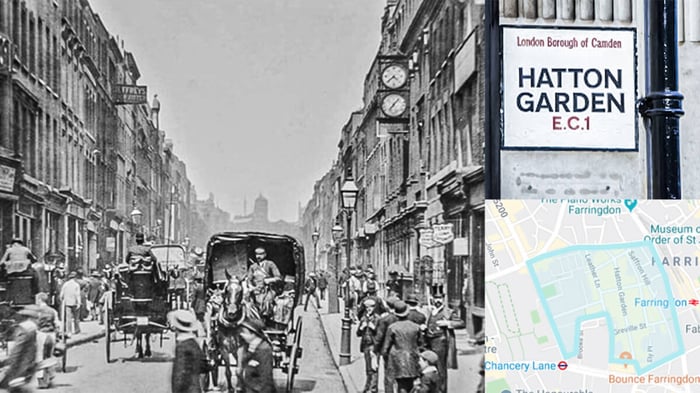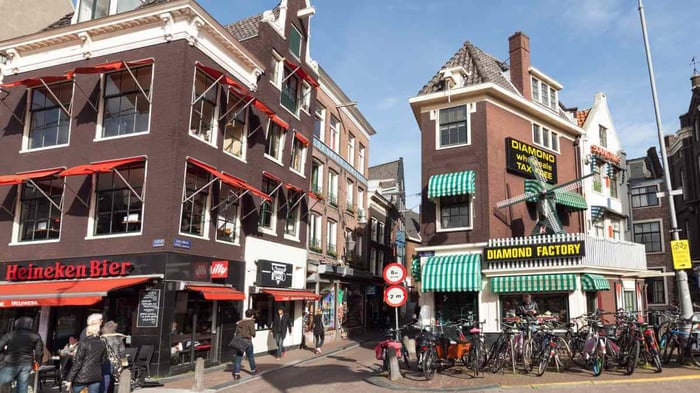The Secret History Of Hatton Garden - London's Diamond District
Hatton Garden is known by many people as being the historic heart of Britain’s high-quality jewellery business. This small area of London is home to the largest diamond and jewellery quarter in the United Kingdom. Hatton Garden, an area of less than one square mile, is today well known across the globe for its high-quality craftsmanship and expertise in all matters jewellery related and, in particular, diamonds.
How Did Hatton Garden Become Famous?
In medieval London, it was customary for different trades and crafts to be clustered in specific parts of the city. Even many hundreds of years ago, London was a large city, but transport was difficult, so it made sense for businesses of the same type to cluster together. In this way, businesses could access the goods and services, they needed to make their products.
The land that is now known as the Hatton district was acquired by Sir Christopher Hatton in 1570. Hatton was Queen Elizabeth’s Lord Chancellor and, reputedly, her lover. As a reward for his services, Queen Elizabeth arranged for him to have the leasehold of the area of Holborn that has become Hatton Garden.
The Hatton family grew short of money, and so they began, in the late 17th century, to lease and sell off some of the lands on their estate. The new residential development allowed wealthy merchants and businesses to move in, build homes and set up their businesses. The first houses were built along the road that is today called Hatton Garden. The area was very much a high-class area with beautiful homes for the wealthiest of people such as lawyers, city officials and merchants. The area was also popular as a second home for the wealthy whose main residence was outside London. The abundance of wealthy people provided the impetus for the growth of the jewellery business for which the area is famous today.
Across London, other areas that developed similarly, many much older than Hatton Garden. Covent Garden, famous for fresh fruits and vegetables and the vast market where produce was sold, skinners and leather workers congregated around Walbrook, Smithfield has been renowned for centuries for its meat market and The City, or Square Mile for financial trading and banking. Many of these areas are no longer connected to their historic trade roots, but Hatton Garden remains tied to its jewellery and diamond trading and working heritage.
The Diamond Connection
The connection to the jewellery trade arose in the 19th century spreading out from the older jewellery quarter in adjacent Clerkenwell. In 1836, 13 jewellery related businesses were recorded in the area. By the end of the 19th century, there were almost 100 diamond dealers and polishers operating. The boom was fuelled at first by The East India Company which was, for many years, the largest source of diamonds in the world. The East India Company imported diamonds from mines in India to Hatton Garden. Then came De Beers, the name which is intimately tied to Hatton Garden’s place in history. The connection grew up following the development of diamond mining in South Africa and the most productive diamond mine in the world, the De Beers mine (now called the Kimberley Diamond Mine.
0.35ct Emerald & 0.15ct G/SI Diamond Necklace in 18k White Gold

$1,019.00
$1,524.00
Hand-cut diamonds encircle the fresh, pleasant green of emerald to wonderful effect in this classic, handcrafted pendant necklace. The shimmering sparkle of 18k white gold is the ideal setting for the ethically sourced gemstones arrayed here. This is a necklace… read more
The South African diamonds flowed to Hatton Garden where they were traded and cut into jewellery. In 1888 a consortium of ten Hatton Garden jewellers called The London Diamond Syndicate, and Cecil Rhodes’ De Beers Consolidated Mines Limited, merged their businesses leading to a virtual monopoly on the global diamond supply. Anyone who wanted access to the best of the world’s diamonds needed to be in London, in Hatton Garden.
Even today when De Beers no longer operates its monopoly on diamonds, the best jewellers and diamond traders need to have a presence in the locale.
De Beers had their headquarters in Hatton Garden, on Charterhouse Street, the company still operates from the same building, but the headquarters is now in Jersey. At the peak of De Beers’ influence, almost 90% of the world's diamonds passed through the De Beers building. The company would store diamonds in a network of underground vaults, holding onto supply to drive up their price.
As the global epicentre of the diamond trade, it was natural that businesses reliant upon diamonds would remain clustered around the area. Today there are around 300 jewellery businesses and more than 70 jewellery shops in the district.
The Biggest Diamond Heist
In 2015, over the Easter Holidays, The Hatton Garden Safe Deposit Company was robbed by a gang of four old men. The thieves were all experienced at their trade and were able to drill through the 50cm thick vault walls and got away with as much as £200 million in jewels. The full amount will probably never be known.
The gang took advantage of the Jewish Passover Holiday; the area is traditionally Jewish and so was unusually quiet, giving the thieves plenty of time to break into the vaults and safe deposit boxes. Eight men have now been convicted in connection with the robbery but only a small part of the loot has been tracked down.
Oddly enough, although many jewellers suffered losses as a result of the robbery, the publicity associated with the case served to raise public awareness of Hatton Garden and its connection with the jewellery business, cementing its status in the mind of the public even further!
Hatton Garden, More Than Jewels And Diamonds!
As you can expect with an ancient and storied city such as London, there’s much more to Hatton Garden. For example, Charles Dickens lived there at 48 Doughty Street. Many of his most famous books were written there, and his first two children were born at the house. Today the building is a museum commemorating Dickens’ life. Writing, as he did, about the world about him several locations from his books can still be found today. Gray's Inn appeared in David Copperfield, and Bleeding Heart Yard featured in Little Dorrit. Nearby 8 Saffron Hill was the location of Fagin’s Den; the building was owned by De Beers until it was demolished in the late 1980s.
Although the area is very small, there’s even room for an Italian district sometimes known as Little Italy. Little Italy developed as Italian Immigrants started to replace the thieves and criminals who had previously made the Saffron Hill area their home. Giuseppe Mazzini, an Italian nationalist and revolutionary, was exiled to London in 1840. He started a school for poor children and for several years tried to organise riots and uprisings in Italy. By 1895 there were around 12,000, mainly southern, Italians in the area. Even as recently as the 2011 census nearly 5% of the area’s residents were born in Italy.
Next time you are in London, come and explore the compact, but historic part of London that is modern Hatton Garden. You might even come across a piece of jewellery that takes your breath away!




